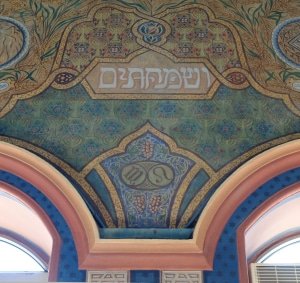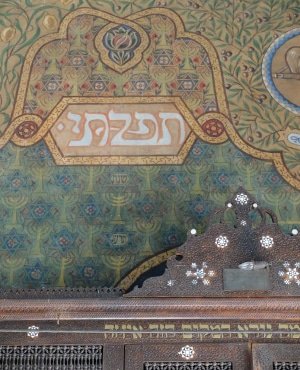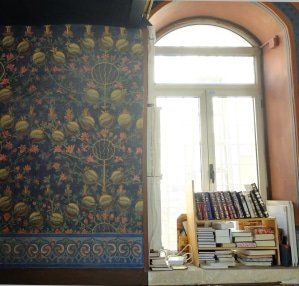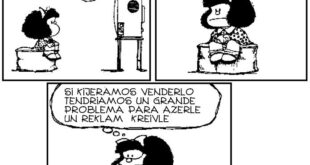Yaakov Stark died penniless and unknown. His murals at the Ades Synagogue are a masterpiece of early Zionist art.

In 1901, in Ottoman Jerusalem, members of the wealthy Ades family funded the construction of a synagogue for Jews who had moved to the city from Aleppo, Syria. It was built off an alleyway near the open-air market of Mahaneh Yehuda, a neighborhood where the other houses of worship were little more than shacks; so although this one was barely the size of a small restaurant, it was called the “Great Synagogue.”
The woodwork inside the Ades (pronounced “Addis”) Synagogue was intricate Damascene carpentry inlaid with mother-of-pearl, a reminder of the community’s Syrian origins. The benches were not arranged facing the front, as in European synagogues, but rather in a rectangle, so that worshipers faced the small central platform where the cantor stood and where the Torah was read, and faced each other, in the more social style of the Middle East.
This was all in keeping with custom. But then the synagogue’s leaders made an unlikely decision: To decorate the walls they would invite an artist not from Syria but from Galicia, and affiliated not with any of the city’s religious communities but with the Zionist bohemians and avant-gardists who had just established an art school nearby.
The young painter, Yaakov Stark, covered the interior with a combination of traditional motifs, like the symbols of the 12 tribes of Israel, and with the new icons of the Zionist movement, stars of David and menorahs, woven together like a mosaic in shades of blue and green. He included a biblical passage expressing the Jews’ longing to return to Zion, using a Hebrew font that mixed Arabic calligraphy with Art Nouveau. Stark’s masterpiece of early Zionist art turned the building from a mere bastion of traditional craftsmanship into something else—a strange, even unsettling amalgam of styles, the physical expression of the conviction of the Syrian worshipers and the Eastern European artist that though they had never met before, and had recently arrived from vastly different places in a city where they had never been, they were all home. There is no other synagogue like it.
Stark died a century ago, shortly after completing the synagogue, impoverished and all but unknown. Now, after a saga involving clashing art restorers, an Israeli court, and the office of the prime minister, one of Israel’s most exquisite buildings has re-emerged after decades of neglect, and with it the reputation of the artist who did so much to make it beautiful.
***
Yaakov Stark moved from Galicia to Jerusalem in 1905, at age 24, with the trickle of Jewish idealists making their way into Turkish Palestine in those years. He earned a meager living drawing postcards and providing occasional illustrations for magazines. He was penniless most of the time; one of the scant records of Stark’s brief life is a note from a shopkeeper demanding payment of a 15-franc debt.
Stark was an early member of the Bezalel art school, which was (and still is) just down the street from the synagogue. The academy was founded by the Lithuanian-born sculptor Boris Schatz, the father of Israeli art, a larger-than-life figure around the dusty backwater that Jerusalem was at the time. Schatz’s goal, as he explained it, was to “find an original Hebrew line, to lay the cornerstone of the Hebrew style.” He was known for flourishes like biblical robes and a pet peacock.
Schatz considered it crucial to meld the new “Hebrew” art with the old world of traditional Judaism, if possible by bringing art into the Orthodox synagogues and study halls of Jerusalem. This, it seems, made the Ades project too good to turn down for his disciple Stark, even though the synagogue couldn’t pay.
A similar project undertaken around the same time by Schatz’s protégés at the famous Hurva Synagogue in the Old City—a synagogue run by Jews of European descent, unlike the Middle Eastern Jews of Ades—ended when the synagogue’s sexton denounced the paintings as idolatrous and defaced them. The Aleppo Jews were more open-minded. Stark spent years on the synagogue murals, finally completing them in 1912.

That same year, a group calling itself The Association of Artists and Painters in Jerusalem, which included Stark, printed an ad in a local newspaper announcing its mission: “to develop the artistic sentiment of beauty among the Jews of our city.” They believed esthetics to be indivisible from the ideas of Zionism; there was no point in returning to the Land of Israel to create something ugly.
The Jerusalem artists’ guild was worried about the appearance of unprofessional painters, “workmen who are not at all expert in this profession, will not only compete with the artists who know their jobs well, but will also ruin the taste of our brothers the residents of Jerusalem, and accustom our eyes not to drawings of beauty and skill but to tasteless drawings corrupt in appearance. The newly rebuilt Jerusalem,” the statement continued, “must be beautiful to all, from the inside and out.”
Two years later, in 1914, world war broke out. Tourism to the Holy Land dried up, and with it orders for artwork. Stark found employment painting houses, and when that wasn’t enough he lived on handouts from Jews in America. He often couldn’t pay rent for the room he shared with his wife and daughter. In 1915, three years after completing the murals, he contracted pneumonia and died; he was 34.
***
In the fall of 2009, the art historian Nirit Shalev-Khalifa was driving away from Jerusalem on the highway to Tel Aviv highway when her cell phone rang. It was a tour guide who had just been to Ades, where she had seen a man painting over the Stark murals. The congregants said it was a restoration.
By this time the murals were grimy and in disrepair. The congregation was never rich and never saw itself as a museum. There were always more pressing needs. The paint was faded and peeling in places, and some sections had been painted over altogether long before. Little remained of the artwork’s original splendor. Khalifa was one of the foremost experts on the murals and was in touch with all of Israel’s conservation arms and restoration experts, but this was the first she had heard of a restoration. It didn’t sound right. She made a quick U-turn and headed back toward Jerusalem.
By the time she walked through the synagogue’s iron gate, pocked with shrapnel from a British bombardment in 1917, it was time for afternoon prayers. She walked upstairs to the women’s section and scanned the walls. The painter was no longer there, but she saw that part of the mural had been covered by a crude approximation of Stark’s original in shiny acrylic. It was, she remembers, “a catastrophe.”

Someone at the synagogue, she discovered, had brought a painter, not a professional restorer, to “renew” the art. The painter’s ad-hoc method was to glue canvas on the mural and recreate the original on the canvas, believing this would preserve what was underneath. But the glue posed an immediate danger to the murals.
Experts from the Israel Museum and the Ben-Zvi Institute, created to preserve the heritage of Middle Eastern Jewry, became involved, without success; the synagogue rebuffed the experts’ attempt to intervene. Ades isn’t public property, and they didn’t want outsiders meddling in their affairs. Israel’s antiquities laws were no help, because they apply only to artifacts that predate 1700. The work continued, and eventually the entire southern wall had been covered with new paint. It looked, Khalifa said, like a cheap wedding hall.
This had been going on for months by the time an official in charge of historic buildings at the Jerusalem municipality happened upon a forgotten bylaw passed in the 1980s, designating 42 buildings as slated for conservation—including, crucially, the interior. One of them was Ades. The art experts went to court, and a judge issued an order finally stopping the work. Khalifa believes this saved Stark’s masterpiece.
***
On a recent Tuesday morning, a small group of men sat on the benches at Ades, drinking coffee, chatting, and chanting psalms, as they do every day. Ades is less a synagogue on the Western model, opening at set prayer times, than it is like a mosque in an Islamic city—a place that is always open, where you can find a conversation, a drink, and respite from the street.
Today the synagogue’s rabbi is Yosef Shayo, 62, a bearded man with a black skullcap. The Shayos are one of the old Aleppo Jewish families. The rabbi’s father, Ezra, was the rabbi before him.
Shayo has watched the synagogue change with the neighborhood over the decades. The old men he remembered as a child studying mysticism in the middle of the night disappeared; an outbuilding next to the main synagogue was taken over by “drug addicts learning Kabbalah,” that being a small but recognized section of Jerusalem’s social landscape. Some people abandoned tradition, and others came back.
Some things didn’t change: The synagogue still chants the Sabbath prayers according to themaqam melodies of Arab music, a different maqam for every week’s Torah portion. Ades is considered the most important center for the Jewish liturgy of Aleppo and the Middle East, and the midnight bakashot prayers in wintertime draw the best cantorial talents and a capacity crowd.
Shayo grew up with Stark’s murals and with the congregation’s memories of the Galician painter: An “impoverished wretch,” in Shayo’s words, so meticulous that he “didn’t leave a millimeter unpainted.”

Shayo believes that Stark was a Freemason, and that he incorporated Masonic symbols into the artwork—he pointed to snakes, Zodiac signs, and a strange menorah with two downward-angled bars through the candelabra. This was a matter of concern for the congregation’s leadership at one time, the rabbi said, but it doesn’t bother him: He consulted with Israel’s Sephardic chief rabbi and was assured that Freemasons posed no threat anymore. (Khalifa, for her part, says there isn’t proof that Stark was a Mason, though she says it’s not impossible.)
When the botched restoration began at the initiative of some in the congregation, the rabbi was unhappy: “I said, this is wrong. This isn’t Stark. We have a pearl in our hands—why alter it?”
After the court halted the work, the section of the prime minister’s office in charge of heritage sites stepped in. The government ended up paying for a professional restoration of the murals, which lasted two years. The ceiling remains to be restored and is concealed in the meantime under a coat of light-blue paint. And other eyesores are waiting to be replaced, like the cheap window frames and old air-conditioning units that mar the walls.
Jewish culture has always expressed itself in words more than in art or architecture: The nomad’s instinct is to build small and cheap, and this turns out to be hard to shake even after a few static generations. Israeli Judaism is varied and thriving but has nothing to compete with the great buildings of Christianity or Islam. Jerusalem’s best attempt at a monumental house of prayer, the modern “Great Synagogue” on the outskirts of downtown, evokes not the Great Mosques of Cairo or Istanbul but rather a temple in suburban New Jersey, circa 1981.
This being the case, said Khalifa, the art historian, Israel’s best claim to a masterpiece of Jewish religious architecture is Ades.
She paused, as if to concede the modest size, the battered table with a coffee pot and stacks of dirty paper cups, a few packages of Kleenex on a bench, the other human traces of the irrepressible religious life played out beneath the artwork every day for more than a hundred years.
“We are who we are,” she said, “and this is our Sistine Chapel.”
By Matti Friedman|January 5, 2015 12:00 AM|
Source: Tablet Mag, a new source of Jewish Life
 eSefarad Noticias del Mundo Sefaradi
eSefarad Noticias del Mundo Sefaradi

